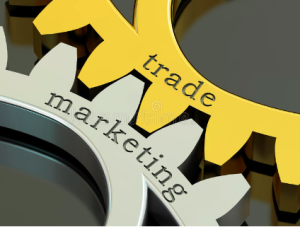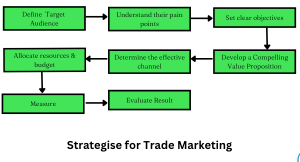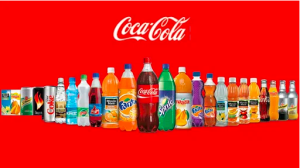Trade Marketing
Trade Marketing
Definition
Trade marketing is promoting and selling products to retailers and wholesalers rather than to end consumers.
Description
It is a business strategy that promotes and sells products to retailers, wholesalers, and distributors rather than directly to end consumers. The goal of trade marketing is to increase sales and distribution of a product by establishing relationships with retailers and wholesalers and providing them with marketing support, incentives, and promotions.

Its activities can include point-of-sale displays, product demonstrations, trade shows, co-marketing initiatives, and other tactics designed to drive product awareness and demand among trade partners. Companies can effectively execute its initiatives to improve their product distribution, increase sales volume, and build strong relationships with key retail partners.
Importance of Trade Marketing
It is important for several reasons:
- Increased sales: By promoting products directly to retailers and wholesalers, it can increase sales volume and revenue for manufacturers and distributors.
- Improved brand recognition: Effective trade marketing can improve brand recognition and awareness among retailers and wholesalers, leading to more shelf space and product visibility in stores.
- Stronger relationships with retail partners: Its initiatives can help manufacturers and distributors build stronger relationships with their retail partners, leading to better collaboration, more favourable shelf placements, and increased sales.
- Better distribution: By working closely with retail partners, it can help ensure that products are distributed effectively and efficiently, reaching the broadest possible audience.
- Competitive advantage: Effective trade marketing can give manufacturers and distributors a competitive advantage by helping them stand out from their competitors and build stronger relationships with key retail partners.
How to Strategise for Trade Marketing?
Here are some steps to strategize for it:

- Define your target audience: Identify the retailers and wholesalers you want to target with your marketing efforts. Consider factors such as geography, size, and product category.
- Understand their needs and pain points: Conduct research to understand your target audience’s needs and pain points. What do they want from their suppliers? What challenges do they face in their business?
- Set clear objectives: Determine what you want to achieve through your efforts. This could include increasing sales, improving brand recognition, or building stronger relationships with retail partners.
- Develop a compelling value proposition: Create a value proposition highlighting your product’s unique benefits and advantages for retailers and wholesalers. This could include pricing, quality, innovation, or support.
- Determine the most effective channels and tactics: Identify the most effective channels and tactics for reaching your target audience. This could include trade shows, point-of-sale displays, co-marketing initiatives, or other tactics tailored to your target audience.
- Allocate resources and budget: Determine how much you will invest in your efforts and allocate resources accordingly. This could include personnel, materials, and other resources.
- Measure and evaluate results: Track the results of your trade marketing efforts and assess their effectiveness in achieving your objectives. Use this information to refine your strategy and tactics over time.
Future Technique of Trade Marketing
The future will likely involve the integration of technology and data analytics to create more personalised and targeted marketing campaigns. Here are some future techniques of trade marketing:
- AI-powered personalization: Artificial intelligence (AI) can be used to analyse data and create personalised marketing campaigns tailored to retailers’ and wholesalers’ specific needs and preferences.
- Augmented Reality (AR): AR technology can be used to create immersive and interactive product demonstrations that help retailers, and wholesalers understand the features and benefits of a product.
- Virtual Reality (VR): VR technology can be used to create virtual trade shows and product demonstrations that allow retailers and wholesalers to experience products more engaging and immersively.
- Blockchain: Blockchain technology can create a more transparent and secure supply chain, which can help build trust and credibility with retailers and wholesalers.
- IoT (Internet of Things): IoT technology can create intelligent products that provide retailers and wholesalers real-time data and insights into product performance, inventory levels, and other vital metrics.
- Social media: Social media platforms can create targeted marketing campaigns that reach retailers and wholesalers directly and build strong relationships with them.
Strategies for Effective Trade Marketing
Some effective strategies that businesses can consider in 2023:
- Personalised Marketing: Tailor your marketing messages to specific customer segments. Leverage data analytics to identify customer behaviour and preferences to provide targeted promotions, content, and experiences.
- Omnichannel Marketing: Integrate all your marketing channels (social media, email, SMS, in-store displays, etc.) to create a seamless customer experience across multiple touchpoints.
- Influencer Marketing: Collaborate with social media influencers with a significant following in your industry to reach a broader audience and increase brand awareness.
- Interactive Marketing: Engage customers with interactive experiences, such as quizzes, augmented reality, and gamification, to create memorable experiences and increase brand loyalty.
- Account-Based Marketing: Target critical accounts with a personalised marketing approach. This involves researching the company, understanding its pain points, and providing solutions that meet its needs.
- Collaborative Marketing: Partner with other non-competing brands to create joint marketing campaigns that benefit both businesses.
- Video Marketing: Use video content to communicate your brand message, showcase products, and engage customers on social media and other online platforms.
- Data-Driven Marketing: Utilise customer data to gain insights into their behaviour and preferences. Use this information to create targeted marketing campaigns that resonate with customers and drive conversions.
- Sustainable Marketing: Incorporate sustainable practices into your marketing campaigns to appeal to environmentally conscious consumers.
- Voice Search Optimization: Optimise your website and content for voice search queries to reach customers who use voice assistants like Amazon Alexa and Google Assistant.
Example
Coca-Cola uses a variety of trade marketing tactics to promote their products to retailers and wholesalers and ultimately increase sales. Coca-Cola creates eye-catching point-of-sale material, such as posters, banners, and shelf talkers, to promote its products in stores.
 Coca-Cola offers retailers and wholesalers promotions and incentives, such as discounts, rebates, and free products, to encourage them to stock and sell more Coca-Cola products.
Coca-Cola offers retailers and wholesalers promotions and incentives, such as discounts, rebates, and free products, to encourage them to stock and sell more Coca-Cola products.
Coca-Cola participates in trade shows to showcase its products and network with potential customers.The brand collaborates with other brands to create joint promotions and campaigns that benefit both businesses.Coca-Cola also provides training and support to retailers and wholesalers to help them sell Coca-Cola products more effectively.
FAQ
What is trade marketing?
It refers to marketing products or services to businesses and other organisations rather than to end consumers. Trade marketing aims to create demand for a product or service among retailers, wholesalers, and other intermediaries who can help distribute and promote the product.
How is trade marketing different from consumer marketing?
Consumer marketing focuses on promoting products or services directly to end consumers. Trade marketing targets intermediaries such as retailers and wholesalers who can help distribute and promote the product to consumers.
What are some examples of trade marketing tactics?
Some common tactics include point-of-sale materials, co-branding, trade shows, training and support, promotions and incentives, and data analysis.
How can trade marketing benefit a business?
Effective trade marketing can help businesses build strong relationships with retailers and wholesalers, increase brand visibility and awareness, and drive sales by creating product demand among intermediaries who can help promote and distribute them to end consumers.
What skills are needed for a career in trade marketing?
Skills that can be helpful include strong communication and relationship-building skills, a strategic mindset, analytical skills, creativity, and the ability to work collaboratively with cross-functional teams.
What is the role of data in trade marketing?
Data plays a critical role in trade marketing by helping businesses understand their target audience, track the effectiveness of their marketing campaigns, and make data-driven decisions about allocating resources and optimising their marketing strategies.





We would love to have your opinion.